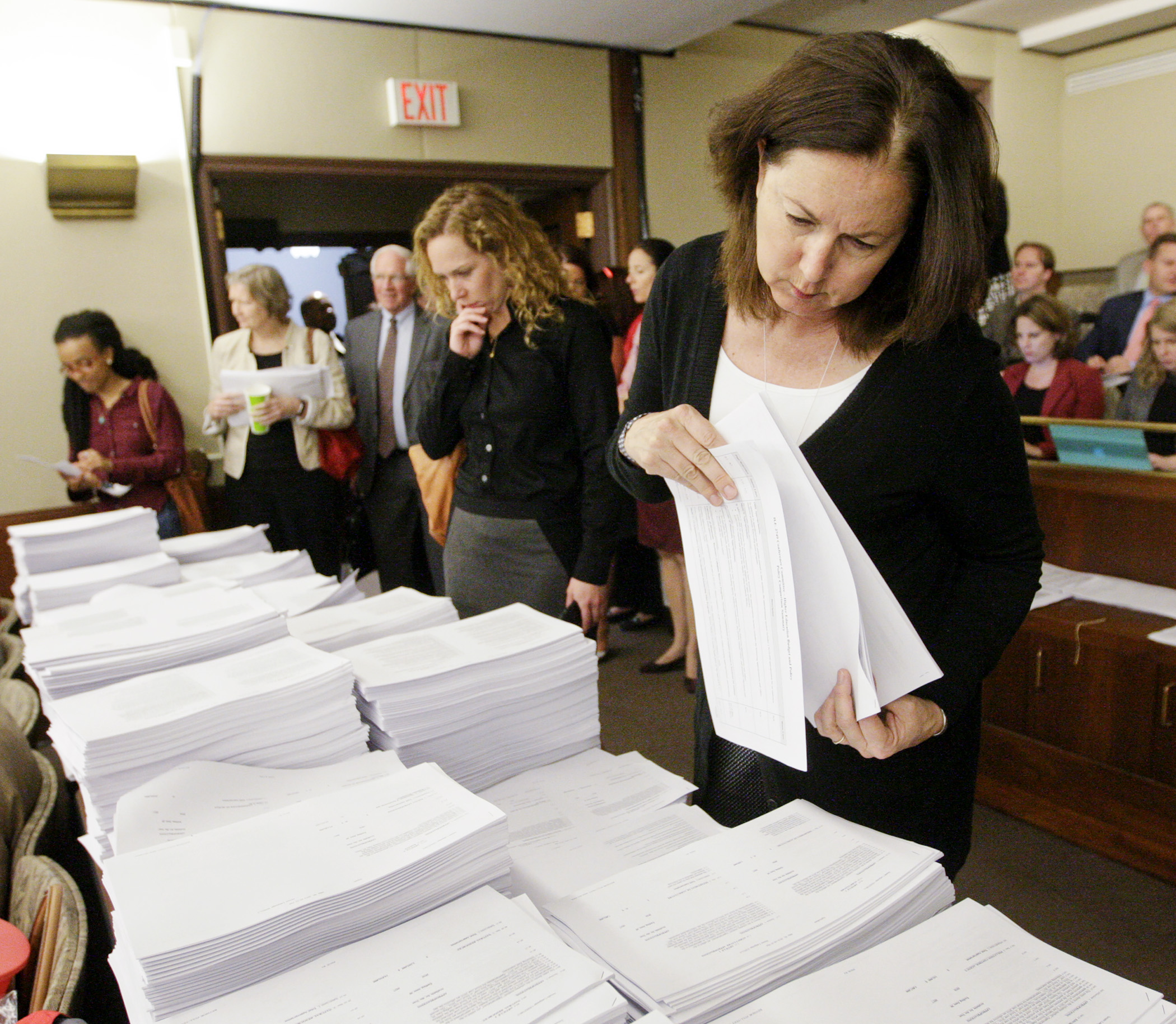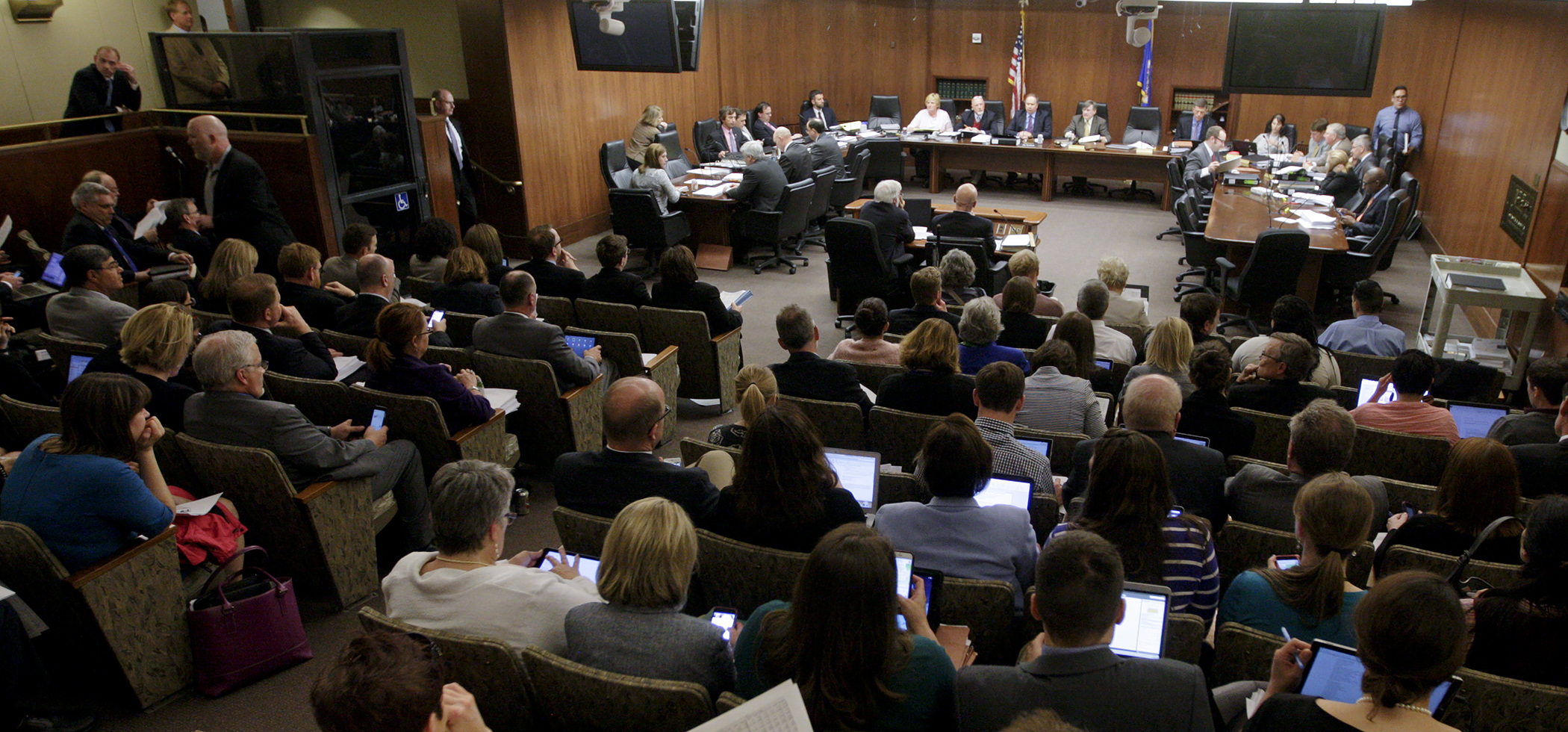Conference committee takes first look at supplemental budget proposals

Hundreds of pages comparing House and Senate versions of the omnibus supplemental budget bill come down to a $453.5 million difference in bottom lines. While the House is proposing just under $3.2 million in net supplemental spending for the biennium, the Senate proposal would spend an additional $456.7 million, just short of Gov. Mark Dayton’s $494.5 million proposal.
With joint budget targets yet to be established, Monday’s first meeting of the conference committee on HF2749 consisted of little discussion as nonpartisan fiscal analysts walked conferees through the broadband, education and health and human services differences between the House and Senate versions of the bill.
Conferees met late Monday evening to go over more items, and are scheduled to meet again at 11 a.m. or at the call of the chair Tuesday in the Minnesota Senate Building.
Let the talks begin
The Senate proposal would increase spending across the board, but under the House proposal, spending would increase only in the areas of environment, transportation and jobs and energy. The House set budget targets of zero for education, higher education and health and human services, and called for budget reductions in agriculture, public safety and state government.
Rep. Jim Knoblach (R-St. Cloud) and Sen. Richard Cohen (DFL-St. Paul) co-chair the conference committee. Other conferees are Reps. Matt Dean (R-Dellwood), Pat Garofalo (R-Farmington), Jenifer Loon (R-Eden Prairie) and Denny McNamara (R-Hastings); and Sens. Michelle Fischbach (R-Paynesville), Tony Lourey (DFL-Kerrick), Tom Saxhaug (DFL-Grand Rapids) and Chuck Wiger (DFL-Maplewood).
Also sitting on the Senate side of the table was Sen. Bobby Joe Champion (DFL-Mpls), who Cohen said would serve as an adjunct member of the committee along with Sen. Jeff Hayden (DFL-Mpls). Champion and Hayden co-chair the Senate Finance Committee’s Subcommittee on Equity, and the Senate’s version of the supplemental budget bill contains a separate equity article proposing $87 million in appropriations for Fiscal Year 2017, primarily in the areas of economic and workforce development and education.
According to the Office of the Revisor of Statutes’ side-by-side comparison, comparable equity funding in the House budget totals about $7.5 million.
Here’s a look at some of the differences between the House and Senate:
Bigger broadband budget
One major difference between the House and Senate supplemental budget bill comes via how to pay for the Border-to-Border Broadband Plan.
The often-debated House version seeks a $15 million appropriation in Fiscal Year 2017 and $25 million in Fiscal Year 2018 to fund the program.
As one-time appropriations, funds would work to provide high-speed Internet access to Greater Minnesota by furthering availability, testing accuracy and deploying development.
The program would be required to reach underserved areas whose households or businesses lack access to wire-line broadband service at speeds greater than 10-20 megabits per second download and three megabits per second upload, as well as unserved areas at speeds greater than or equal to 10 megabits per second download, and three megabits per second upload.
Dayton has requested $100 million in his supplemental budget to expand broadband funding.
WATCH Video of the conference committee's afternoon meeting on YouTube
The Senate version comes much closer to meeting that request, while also adding more speed and additional goals.
That body’s proposal would appropriate $85 million in Fiscal Year 2017 for the employment and economic development of the program, while also upping the ante in terms of speed, requiring the program to service underserved areas at speeds of at least 100 megabits per second download, and at least 20 megabits per second upload. Unserved areas would be serviced with speeds of at least 25 megabits per second download, and at least three megabits per second upload.
The Senate version also adds measureable goals for the program to reach, including all Minnesota businesses and homes having access to broadband at a minimum of 25 megabits per second download, and three megabits per second upload by 2022. The goal jumps to 100 megabits download, and 20 megabits upload by 2026.
E-12 Education
Both the House and Senate E-12 education proposals would leverage about $52 million in anticipated savings from allowing school districts to repay their capital loans early. The House would also cancel a $2 million appropriation for Regional Centers of Excellence.
WATCH Video of the conference committee's evening meeting on YouTube
The Senate proposal would spend an additional $48 million over the House proposal, including $25 million to establish a voluntary prekindergarten program, one of the governor’s education priorities this session.
Both the House and Senate proposals would fund several programs to address teacher workforce shortages. Major spending differences in the House and Senate budget proposals include the following:
- the House would spend $7.7 million to extend equity funding to non-metro districts, the Senate zero;
- the House would spend $5 million on school-linked mental health grants, the Senate zero;
- the House would spend $7 million in broadband innovation grants, the Senate zero;
- the Senate would spend $13 million for “Support Our Students” grants for districts to hire counselors and other support staff, the House zero; and
- the Senate would spend an additional $9.4 million — the House $240,000 — on teacher professional development through the alternative compensation Q-Comp program, and $10 million on teacher development and education for districts not part of Q-Comp.
Higher Education
The House proposal contains no net higher education spending, while the Senate is proposing $47.7 million. The House version contains policy provisions creating additional oversight of two types of research at the University of Minnesota: research using fetal tissue and psychiatric drug trials involving human subjects. (See the side-by-side comparison)
Additional funding proposed by the Senate, but not the House, includes the following:
- $14.3 million for programs to close gaps in postsecondary attainment;
- $13 million for tuition relief for University of Minnesota students;
- $10 million to Minnesota State Colleges and Universities system for campus program support; and
- $5 million for health restoration activities at the university. (See the spreadsheet)
Health and Human Services
The health and human services provisions in the respective omnibus bills have fundamental differences between their major spending and policy items.
The House bill seeks to keep total health and human services appropriations flat. The bill would pay for new spending items by shifting MNsure appropriations – $20 million in Fiscal Year 2017 and $40 million in the subsequent biennium – before completely repealing the program and shifting enrollees onto the federal program in 2017.
 Rep. Jim Knoblach addresses a packed room as the first meeting of the House-Senate supplemental budget conference committee begins May 9. Photo by Paul Battaglia
Rep. Jim Knoblach addresses a packed room as the first meeting of the House-Senate supplemental budget conference committee begins May 9. Photo by Paul BattagliaIt would also implement a variety of new regulations for facilities that perform abortions and prohibit these facilities from being eligible for funds under certain federal family planning grants and state sponsored health care systems. The Senate bill doesn’t contain any of these provisions.
The Senate bill would increase total appropriations by $50.7 million in Fiscal Year 2017 and $140 million in the subsequent biennium. Instead of repealing MNsure, it would increase funding to the program across a wide variety of items aimed at addressing issues with the program.
It also contains smaller versions of items included in Gov. Dayton’s supplemental budget proposal, although most of his biggest spending items were not included.
Notable Senate spending items not included in the House bill include:
- $18 million in Fiscal Year 2017 and $40 million for the subsequent biennium to comply with the U.S. Department of Labor Home Care Worker Final Rule, which provides overtime pay for home workers after 40 hours per week. The item, which was included in Dayton’s budget, increases funding for related reimbursement programs;
- $8.8 million in Fiscal Year 2017 and $25.9 million for the subsequent biennium for a 15 percent increase to the Northstar Care for Children basic monthly reimbursement rates;
- $8 million in Fiscal Year 2017 and $40 million for the subsequent biennium for a 7 percent increase to the child care provider reimbursement rates; and
- $350,000 in Fiscal Year 2017 and $102 million for the subsequent biennium for increasing the MinnesotaCare income eligibility to 275 percent of the federal poverty guidelines. The item was include in Dayton’s budget.
Both bills contain a slate of items aimed at integrating mental health and chemical dependency treatments in the state.
— House Public Information Services writers Nick Longworth and Josh Moniz contributed to this story.
Related Articles
Search Session Daily
Advanced Search OptionsPriority Dailies
Ways and Means Committee OKs proposed $512 million supplemental budget on party-line vote
By Mike Cook Meeting more needs or fiscal irresponsibility is one way to sum up the differences among the two parties on a supplemental spending package a year after a $72 billion state budg...
Meeting more needs or fiscal irresponsibility is one way to sum up the differences among the two parties on a supplemental spending package a year after a $72 billion state budg...
Minnesota’s projected budget surplus balloons to $3.7 billion, but fiscal pressure still looms
By Rob Hubbard Just as Minnesota has experienced a warmer winter than usual, so has the state’s budget outlook warmed over the past few months.
On Thursday, Minnesota Management and Budget...
Just as Minnesota has experienced a warmer winter than usual, so has the state’s budget outlook warmed over the past few months.
On Thursday, Minnesota Management and Budget...
